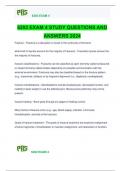6202 EXAM 4
6202 EXAM 4 STUDY QUESTIONS AND
ANSWERS 2024
Fracture - Fracture is a disruption or break in the continuity of the bone.
what kind of injuries account for the majority of fractures - Traumatic injuries account for
the majority of fractures.
fracture classifications - Fractures can be classified as open (formerly called compound)
or closed (formerly called simple) depending on possible communication with the
external environment. Fractures may also be classified based on the fracture pattern
(e.g., transverse, oblique) or by fragment alignment (i.e., displaced, nondisplaced).
fracture manifestations - Manifestations include localized pain, decreased function, and
inability to bear weight or use the affected part. Obvious bone deformity may not be
present.
fracture healing - Bone goes through six stages of healing (union).
Many factors influence union (e.g., age, blood supply, infection, hormones,
immobilization, and site of the fracture).
Goals of fracture treatment - The goals of fracture treatment are anatomic realignment
of bone fragments, immobilization to maintain realignment, and restoration of function.
6202 EXAM 4
, 6202 EXAM 4
closed reduction for fractures - Closed reduction is the nonsurgical, manual realignment
of bone fragments. Treatment following reduction includes traction, casts, splints, and
braces.
open reduction for fractures - Open reduction is the correction of bone alignment
through surgery. It may involve the use of wires, screws, or pins placed internally or
externally.
traction for fractures - Various types of traction may also be used to immobilize
fractures.
fracture immobilization - Fracture immobilization may be accomplished using a cast.
The cast usually restricts the joints above and below the fracture. Patients require
teaching about signs of cast complications so that they can contact the HCP promptly.
fracture immobilization - for upper extremity injuries - For upper extremity injuries:
sugar-tong splints, posterior splints, and short- and long-arm casts are used. A body
jacket brace is often used for stable thoracic and lumbar spine injuries.
fracture immobilization - for lower extremity injuries - For lower extremity injuries:
cylinder, long- or short-leg casts; Robert Jones dressings; or splints/immobilizers may
be used.
internal and external fixation - · External and internal fixation devices may also be used
to immobilize fractures.
Wires, screws, intramedullary nails, or pins can be used to perform ORIF.
6202 EXAM 4
, 6202 EXAM 4
For external fixation, a metal frame is attached to the bone fragments with pins through
the skin.
nursing assessment for fractures - Fractures require nursing assessment of peripheral
circulation (color, temperature, capillary refill, peripheral pulses, and edema) and
neurologic function (sensation and motor function).
nursing care for fractures - Nursing care involves comfort measures for pain,
interventions to prevent complications associated with immobility, and nutritional
support.
postop care for fractures - Postoperative care following ORIF involves applying the
general principles of postoperative nursing care.
possible complications of fractures - Possible complications of fractures include bone
infection, avascular necrosis, compartment syndrome, VTE, FES, and shock.
Colles' fracture - A Colles' fracture is a fracture of the distal radius. Manifestations are
pain, swelling, and obvious deformity of the wrist.
Colles' fracture management - Management usually is by closed reduction and
immobilization by splint or cast. If the fracture is displaced, internal or external fixation
may be used.
humeral fractures common in what age group - Fractures involving the humeral shaft
are a common injury among young and middle-aged adults.
humeral fracture manifestations - Manifestations include obvious displacement,
shortened extremity, pain, and abnormal mobility.
6202 EXAM 4




